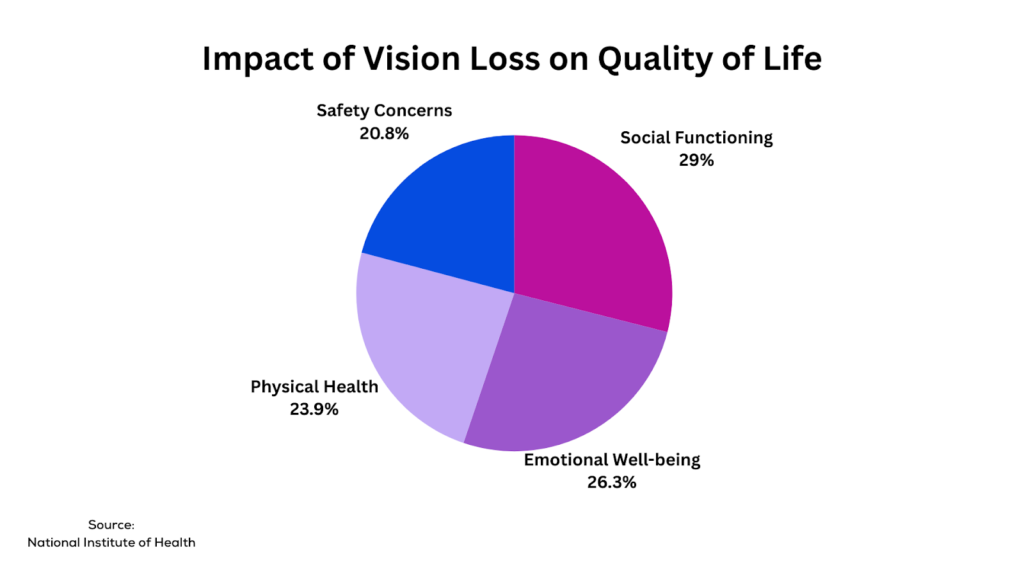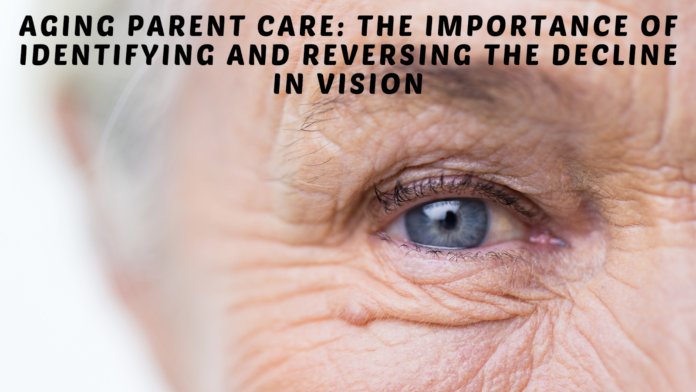Last Updated on July 21, 2024 by Nasir Hanif
As our parents age, their overall well-being becomes increasingly concerning. They may face many health challenges. Vision impairment and blindness are key causes of disability in older adults. Quality of life in the elderly closely correlates with their vision health, underscoring the importance of promptly identifying and addressing any decline.
Recognizing the direct impact of vision on quality of life lays the groundwork for identifying the early warning signs of vision decline. Noticing these signs is pivotal to mitigating their consequences. Talking to a primary care physician can be the first step in addressing vision concerns for aging parents. This can be a primary care doctor or an adult gerontology primary care provider.
Table of Contents
Early Signs of Vision Decline in Aging Parents
As our parents age, it’s essential to be vigilant for the early signs of vision decline. These signs can be subtle but have profound implications for their overall well-being. Common symptoms to watch for include:
- Difficulty adjusting to light: Aging parents may squint or take longer to adjust when moving from bright to dimly lit areas, or vice versa.
- Trouble reading: If your parents hold reading materials unusually close or far away, or if they complain about blurred print, it could indicate vision issues.
- Color vision changes: A decreased ability to distinguish between certain colors, particularly shades of blue and purple, can be an early indicator of vision decline.
Ignoring these early signs can have psychological and physical impacts on aging parents. Vision loss can lead to social isolation, decreased mobility, and an increased risk of falls and injuries. Recognize these signs early. Then, take steps to address the causes and reduce their effects.
Common Vision Problems in the Elderly
Many vision problems are prevalent among the elderly, contributing to vision decline. Understanding these conditions is crucial. They help identify and address the root causes of vision changes in aging parents.
- Cataracts: A cataract is a clouding of the eye’s natural lens, which can cause blurred vision, sensitivity to light, and difficulty with night vision.
- Glaucoma: This group of eye diseases damages the optic nerve, often due to increased pressure within the eye. If left untreated, glaucoma can lead to permanent vision loss or blindness.
- Age-related Macular Degeneration (AMD): AMD affects the macula, the retina’s central portion responsible for sharp, detailed vision. It can cause blind spots or distorted vision, making it challenging to read, drive, or recognize faces.
- Diabetic Retinopathy: This condition, caused by diabetes, damages the blood vessels in the retina, leading to vision loss or blindness.
Identifying the specific vision condition is essential for tailoring the best treatment and care plan. Consulting primary care doctors or specialists can aid in diagnosing and managing these conditions effectively.
The Role of Regular Eye Exams
Acknowledging these conditions is critical. But, the power of prevention and early detection through regular eye exams is vital. Eye exams are crucial. They maintain eye health and prevent further vision decline in aging parents.
During an eye exam, healthcare professionals can:
- Detect vision problems early, before they become more severe
- Monitor existing conditions and adjust treatments as needed
- Identify risk factors for developing age-related eye diseases
- Guide lifestyle changes and adaptations to accommodate vision changes
Regular eye exams detect problems early, facilitating access to new treatments that can significantly improve or even reverse vision decline. If you’re looking for a primary care doctor, consult resources on how to choose a primary care physician to find the right fit for your aging parent’s needs.
Advances in Treatment Options
Modern medicine has made remarkable strides in treating common vision problems among the elderly. These advancements offer hope for slowing or reversing vision decline. They will improve the lives of aging parents.
- Cataract Surgery: This outpatient procedure involves removing the clouded natural lens and replacing it with an artificial lens, restoring clear vision.
- Glaucoma Treatment: Various medications, laser treatments, and surgical procedures can manage and slow the progression of glaucoma, preserving vision.
- AMD Therapies: While there is no cure for AMD, treatments like injectable medications and nutritional supplements can slow its progression and, in some cases, improve vision.
- Diabetic Retinopathy Treatment: Controlling blood sugar levels, laser treatment, and injectable medications can help prevent or reverse vision loss caused by diabetic retinopathy.
Early detection and timely intervention can manage many vision problems well. This lets aging parents keep their independence and quality of life.
| Vision Condition | Treatment Options | Potential for Vision Improvement |
| Cataracts | Cataract surgery (lens replacement) | Significant improvement or restoration of clear vision |
| Glaucoma | Medications, laser treatment, surgery | Slows progression, preserves remaining vision |
| Age-related Macular Degeneration | Injectable medications, nutritional supplements | Slows progression, potential for improved vision in some cases |
| Diabetic Retinopathy | Blood sugar control, laser treatment, injectable medications | Slows progression, potential for vision improvement with early treatment |
Lifestyle Adjustments and Home Safety Modifications
Modern treatments offer hope. But, adding lifestyle adjustments and home safety mods is equally vital. They enhance our aging parents’ life quality. As their vision declines, simple adaptations can make a significant difference in their daily lives.

Lifestyle Adjustments:
- Increase lighting levels and strategically place task lighting
- Wear sunglasses or anti-glare lenses to reduce glare
- Organize belongings and declutter living spaces for easier navigation
- Use magnifiers or large-print materials for reading
- Engage in regular physical activity to maintain overall health
Home Safety Modifications:
- Install handrails and non-slip surfaces to prevent falls
- Use contrasting colors to define edges, steps, and transitions
- Ensure adequate lighting in hallways, staircases, and bathrooms
- Remove trip hazards like loose rugs or cords
- Utilize voice-activated or large-button devices for ease of use
By adapting the environment to accommodate vision changes, you can empower your aging parents. They can keep their independence and reduce the risk of accidents or injuries. Consult with senior care professionals or occupational therapists for personalized recommendations.
Navigating Insurance and Financial Assistance for Vision Care
Adapting to vision loss through lifestyle changes is key. Navigating the impact of vision loss and costs of care through insurance, Medicare, and other aid makes these changes possible and lasting.
Insurance Options: Many health insurance plans cover routine eye exams and treatments for vision-related conditions. Review your parents’ policy details and coverage limits to understand their benefits.
Medicare Benefits: Medicare Part B covers certain preventive and diagnostic eye exams, as well as treatments for conditions like glaucoma and diabetic retinopathy. However, routine vision care and eyeglasses may not be covered.
Financial Help Programs: Various organizations and state programs offer financial assistance for vision care services and treatments, such as:
- EyeCare America (for eligible individuals aged 65 and older)
- Vision Service Plan (VSP) Sight for Students (for eligible children)
- State-based vision assistance programs (eligibility varies by state)
Explore these resources. They will ensure that cost does not block access to the care and support your aging parents need for their vision.
Conclusion
We are exploring ways to get money and care plans. We recommit to not just saving vision but also improving the well-being of our aging loved ones. Regular check-ups and proactive care stand as our best defense in this ongoing endeavor.
Identifying and addressing vision decline in aging parents is complex. It requires vigilance, understanding, and a holistic approach. We can help our loved ones maintain their independence and quality of life. How? By spotting early signs. Know common vision problems. Get regular eye exams. Embrace treatments. Make lifestyle changes. Use financial resources.
Remember, taking proactive steps today can ensure a brighter tomorrow for our aging parents. It will allow them to navigate their old age with confidence and clarity.
Call to Action
Take action today if you’re concerned about your aging parent’s vision. Consult with their main doctor or an adult gerontology primary care provider. They will help you schedule a thorough eye exam. Finding problems early and acting on them can make a big difference. It can preserve their vision and overall well-being.
FAQs
Experts generally recommend that adults aged 60 and older have full eye exams at least once a year. However, those with existing vision conditions or risk factors may need more check-ups more often. Their primary care physicians or primary care providers advise this.
While full vision reversal may not always be possible, many age-related eye conditions can be effectively managed with the right treatment. Early intervention and adherence to prescribed treatments can often improve or stabilize vision, preventing further decline.
Caregivers can access a wide range of resources to help manage the vision care of aging parents effectively. Support groups, educational resources, and professional assistance are available. These resources are offered by organizations such as the American Foundation for the Blind. The National Eye Institute and local vision rehab centers also provide them.
Apart from that if you want to know about “I Don’t Want To Care For My Elderly Parents” then please visit our “Health” Category.























